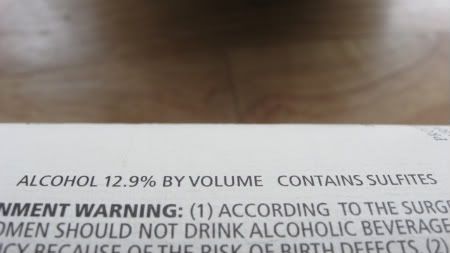There is certain to be lots of drinking this holiday season. And with drinking comes the inevitable hangover headache. Drink too much of anything, and you are sure to be hit with a hangover the next morning.
But forgetting about the hangover in general for a moment, what I want to discuss today is a common misconception regarding the cause and effect relationship between RED WINE and headaches. There are many people who frequently come down with a headache following some red wine drinking. This is indisputable. What I want to clear up however is people’s fear of the RED WINE HEADACHE, and what those who suffer from said headache can do to avoid the uncomfortable after-effect.

I have heard from countless people about their presumed allergy to red wine. Or allergy to sulfites. How they can drink white wine, but not red. I have learned a lot about this, including the concept that in all likelihood many people who think they are allergic to sulfites probably are not. FYI – dried fruit and salad bars contain a much higher level of sulfites than does red wine. And oh yeah, white wine has plenty of sulfites as well, both naturally occurring sulfites and added sulfites (usually).
As always, if you have specific questions feel free to be in touch. But without further ado, I’d like to reprint an article written by Jennifer Rosen (for localwineevents.com) titled “Red Alert: taming the red wine headache“. A funny & informative read. One that I hope clears up this issue for many of you who fear the RED WINE HEADACHE…
Happy holidays & HAPPY HEADACHE FREE WINE TASTING!
WTG
Judging by my e-mail, an alarming number of you have quit drinking red wine because it gives you a headache. Do not go gentle into that good night! As inventions go, red wine ranks right up there with indoor plumbing, novocaine and the wheel. More than a great pleasure, it’s been shown to prevent heart disease, osteoporosis, cancer, memory loss and memory loss. (Note to self: drink more red wine).
I’ll bet people nag you, “Oh, come on, try a little. You’re just being hypersensitive!” At last, you are vindicated, because now your condition has an official name. If you’re one of those folks who gets a pounding headache, perhaps with nausea and flushing, within an hour or less of drinking even a small glass of red wine, you have Red Wine Headache Syndrome.
Since RWHS research has nothing to do with weight loss or baldness, and it’s not sexually transmitted, it doesn’t get much press. But, rest assured, scientists are working hard on your problem, and the latest studies conclude…that they haven’t the slightest idea what’s going on. Which is a big improvement over when they thought they knew, and were wrong. But there is still hope for you. Let’s start by busting a few myths.
First, the culprit is NOT sulfites. All wine contains sulfites, or SO2. For thousands of years, winemakers have welcomed its stabilizing effect, adding it at crucial intervals during vinification. Only American labels require the ominous warning, “Contains Sulfites,” if the level exceeds ten parts per million. This happens to be about the level you get if you don’t add any, since SO2 is a natural presence on grape skins. That’s why another label you might have seen, “No Sulfites Added,” is a bit disingenuous. However, the point is moot anyway, unless you are one of the very few, severely steroid-dependent asthmatics who actually is sulfite-sensitive. If so, you react much more violently to dried fruit, hot dogs and many other processed foods, because they have thousands of times the SO2 found in wine.
Second, it’s probably not the histamines, unless your headache comes with itching, sneezing, shortness of breath and diarrhea. If so, red is indeed the enemy, since the devil is in the skins, which give red its color. Good news! Taking an antihistamine before drinking should prevent the reaction. Just make sure to choose a non-drowsy formula, if you want to remember the evening instead of being remembered as the one who slid under the table.
The latest theory is that RWHS is caused by prostaglandin, which certain people lack the wherewithal to metabolize. Scientists admit that it might be caused by yet another substance, probably something in the strains of yeast or bacteria found in red wine. But they vow to soldier on until they’ve cornered the enemy, despite the obvious strain of having to drink all that leftover red wine in the lab.
But, more good news! Former sufferers are getting results from prostaglandin-inhibitors, namely Ibuprophin & Nuprin, as well as the weaker, but workable, aspirin. Take them less than an hour before drinking and chances are no headache will develop. If you should wake up the next morning with a headache, what you’ve got is known as “a hangover,” a medical condition that definitely deserves more research.
Best bet is to test this preventative with just a few sips of wine. And since I’m not a doctor, though I play one in the bedroom with my boyfriend, you should certainly consult your M.D. first.
So, now you, too, can be a wine snob, with your very own Wine Syndrome! When the conversation turns to MLF or carbonic maceration, try tossing in, “I find the aggressive delivery of RWH in this Volnay surprisingly muted by the prosto-inhibitors, don’t you?” Then smile mysteriously and enjoy, at long last, your red.






